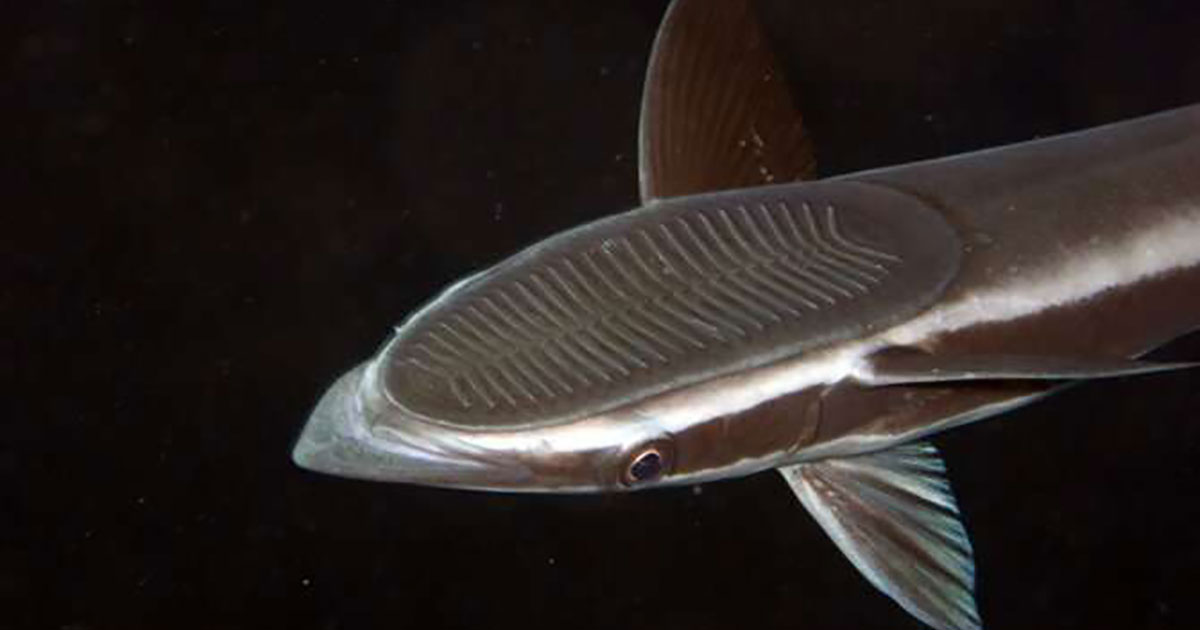As the hitchhikers of the marine world, the remora fish is well known for getting free rides by gripping onto hosts with its suction disc, a highly modified dorsal fin on its head. Now, work investigating the suction disc -- appearing February 26 in the journal Matter -- reveals that one of the secrets to the fish's strong grip lies within the unique architecture of the lip of the disc.
"The remora fish's body shape and poor swimming ability don't give him an edge in nature," says senior co-author Li Wen of Beihang University, describing the flat-headed, eel-like fish. "The fish had to evolve its fin into a suction cup for hitchhiking for two reasons: food and mating."
The suction disc of the remora -- also known as the suckerfish or sharksucker -- is so powerful that the fish can even stay attached to leaping dolphins. To understand the underlying mechanism, the researchers looked into the tissue on the soft lip of the suction disc. Between the surface and under-skin layer, they discovered a unique structure: vertically oriented collagen fibers. The fibrous structure provides elasticity for maximizing contact with substrates and decreases the deformation of the lip to maintain its adhesive force. This is the first paper to reveal the detailed morphology structure of the lip disc tissue in remora fish.
"Our research about remoras started with our co-senior author Li Wen's study on sharks' skin structure," said corresponding author Juan Guan of Beihang University. "We were fascinated by the fact that remoras' suction disc can adhere to surfaces as rough as sharkskin. Sharks swim very fast, yet remoras can hold on to the sharks' skin very tightly."
Inspired by the fish, researchers engineered a biomimetic disc infused with vertical nylon fibers with electrostatic flocking, a technique that utilizes an electric charge to align fibers. Compared to pure silicon discs, the biomimetic discs demonstrate an adhesion enhancement of 62.5% and show 3.4 times increment in attachment time. Moreover, the fiber-reinforced biomimetic sucker can hang onto objects that are heavy, irregular, rough, and even under aquatic conditions.
"There are some limitations in controlling the fiber density," says Guan. "Although nylon and collagen are similar to some extent, we can't fully mimic their morphological and chemical composition. But we proved a simple concept: by adding vertical fibers to your sucker, you can improve the sucker's functionality significantly. We're doing work that can be applied in real life."
The next step for the team is to improve the current biomimetic sucker by studying and mimicking the structure on the surface skin and under-skin layer. Other improvements include introducing environmentally friendly and biodegradable materials such as silk. The development of vertical fibers could also be applied in soft robotics to achieve intricate movements through controlling deformation.
"There's a lot of potential in future applications," says Wen. "I'm a mechanical engineer; I make robots. If we can make a robot with a suction disc as strong as the remora's, it could travel the world attached to whales and sharks. The mobile biomimetic device will be able to gather meaningful bio and environmental data. I hope the suction disc can be applied to protecting the marine environment and contribute to the marine bio-monitoring system in the future."
This work was supported by the Fundamental Research Funds for the Central Universities, National Natural Science Foundation of China support projects, and National Key R&D Program of China.
Journal Reference: Siwei Su, Siqi Wang, Lei Li, Zhexin Xie, Fuchao Hao, Jinliang Xu, Shaokai Wang, Juan Guan, Li Wen. Vertical Fibrous Morphology and Structure-Function Relationship in Natural and Biomimetic Suction-Based Adhesion Discs. Matter, 2020; DOI: 10.1016/j.matt.2020.01.018
Story by Cell Press



